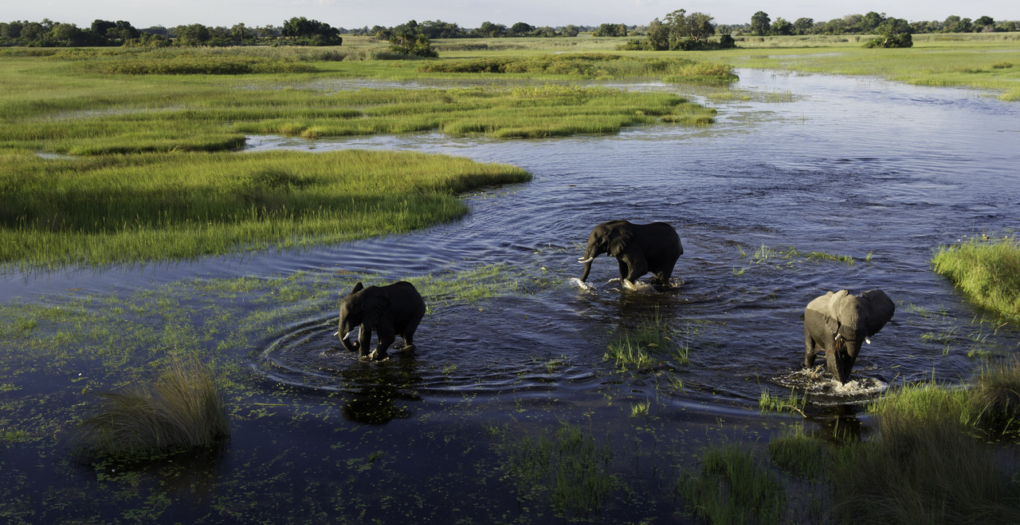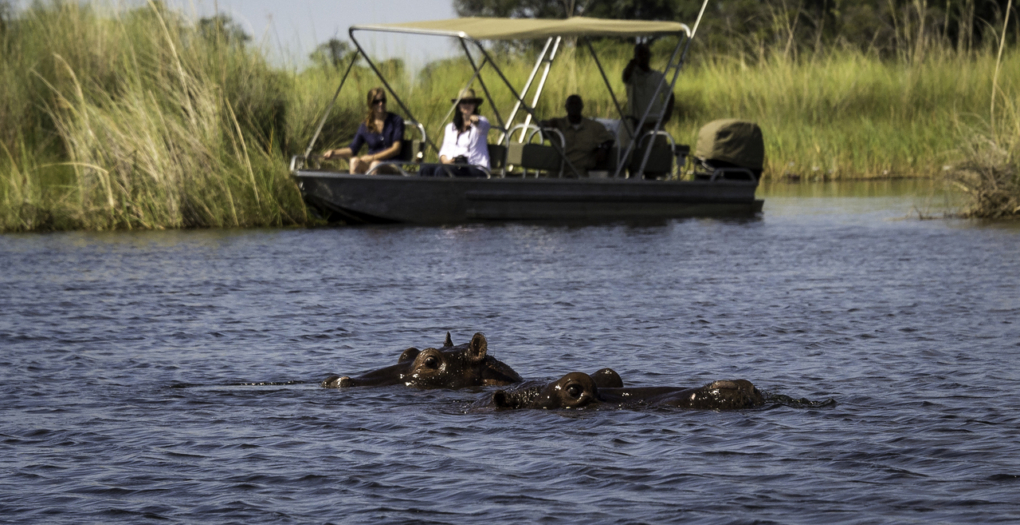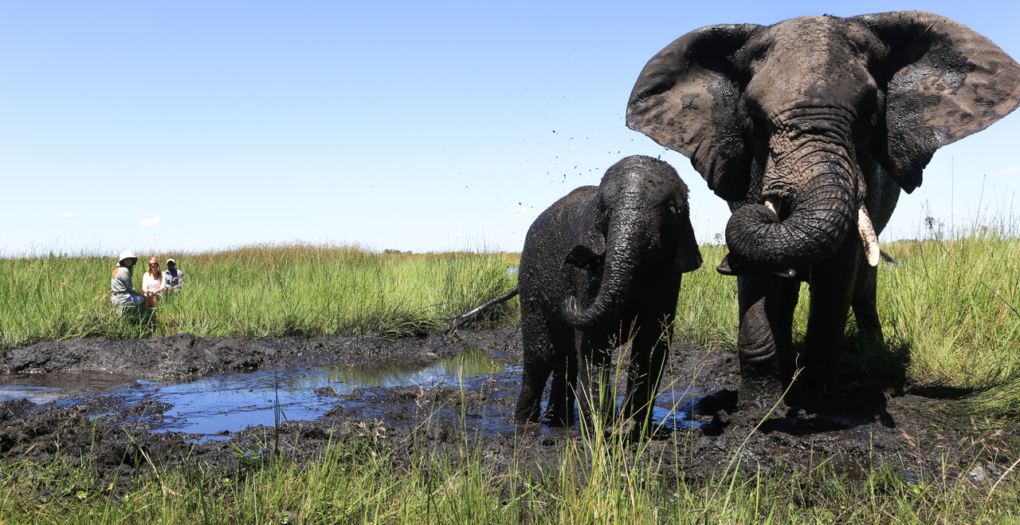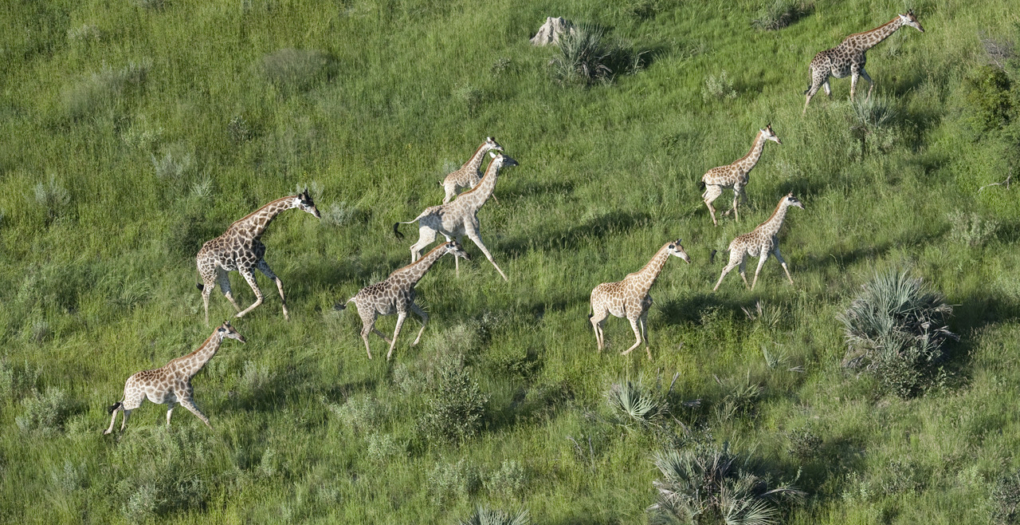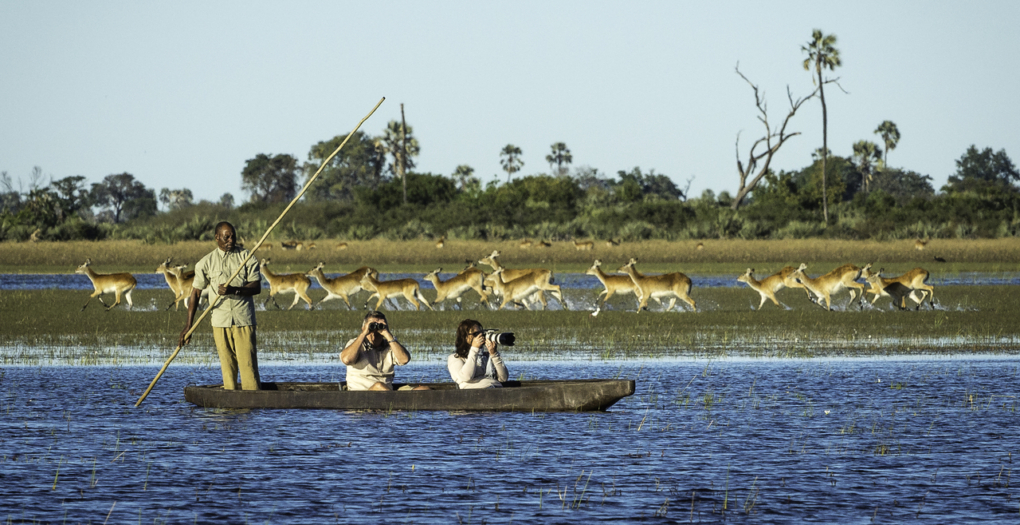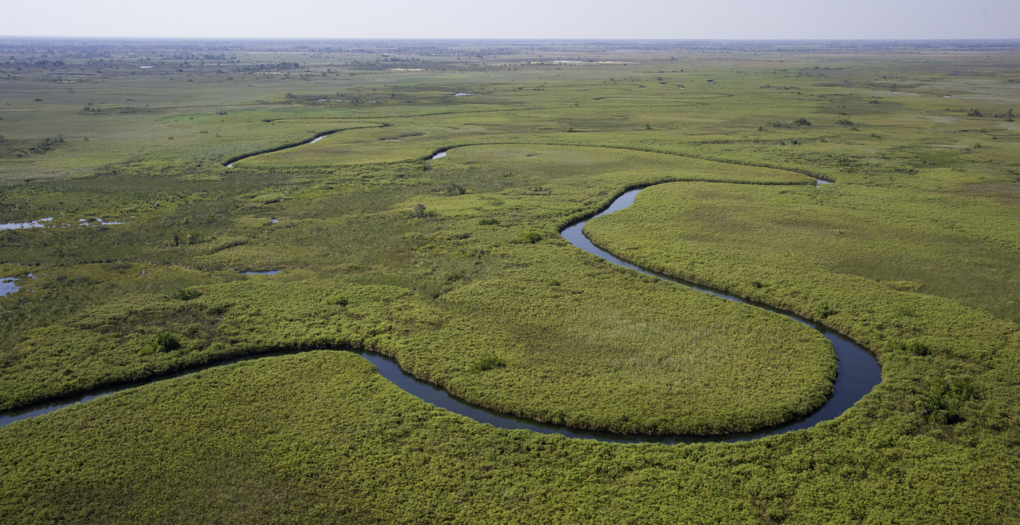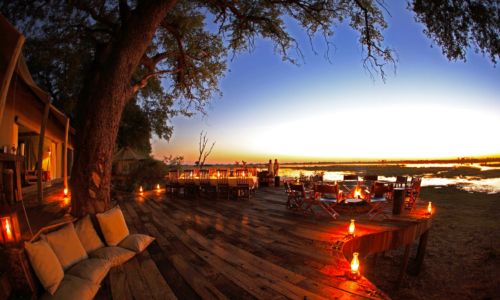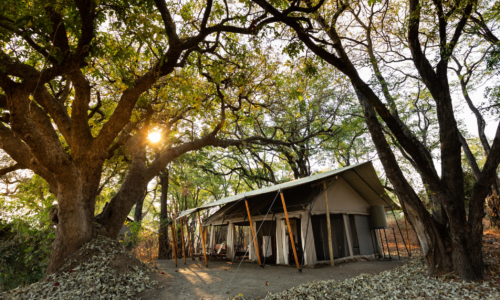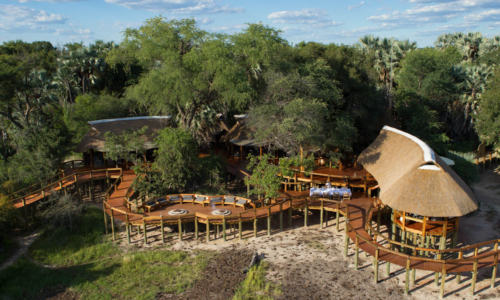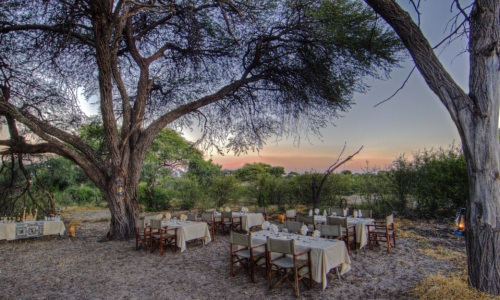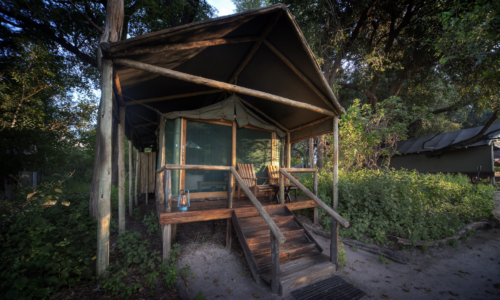The swampy delta is formed by seasonal flooding of the Okavango River during the dry season. The floodwaters flow from the Angola highlands across Namibia’s Caprivi Strip before it empties into the harsh Kalahari Desert basin. Known as the “jewel of the Kalahari the flood waters cover an area of over anywhere from 9,000 square miles in the drier season to 13,000 square miles in the wetter season. As part of the African Rift Valley System its geography has resulted in the ‘capture’ of the Okavango River that has formed the Delta and its extensive waterways, swamps, flooded grasslands, and floodplains. But the Rift Valley also makes the water’s flow, distribution, and drainage patterns continually change due to tectonic activity underground.
The Okavango is divided into three areas. The panhandle where the river runs deep and wide and the swamps are perennially flooded. Here the papyrus beds and phoenix palms are home to many bird species and fishing is popular. At Seronga, the Delta forms a fan where the waters spill over rejuvenating the land and creating a variety of channels, lagoons, ox-bow lakes, flooded grasslands, and thousands of islands of all shapes and sizes. It’s covered in reeds, mokolwane palms, acacia, sycamore fig, sausage trees, raintrees, and African mangosteen. Finally, it turns into dry land forming the Matsebi Ridge, Chief’s Island, and the Moremi tongue and is dotted with salt pans.
Not surprisingly, this oasis attracts some of the world’s highest concentrations of wildlife, including all the quintessential African mammals from lion to elephant to hippo to giraffe to rhino to zebra as well as crocodiles, hyena, cheetah, leopard, sable antelope, buffalo, zebra, warthog, and chacma baboon. The delta is also the permanent or seasonal home of hundreds of bird species as well. Due to a reintroduction program, there are now about thirty-five white rhino and four black rhino in the Delta.
Now a UNESCO World Heritage Site, the Okavango offers many unique activities to explore its diverse eco-systems. A special way to enjoy the waterways is by mokoro, a traditional dug-out canoe steered by a long pole. Motor boat tours also take guests on cruises of the waterways and lagoons. Anglers will enjoy catch and release fishing tilapia and the famous tigerfish. Game drives in 4×4 vehicles are available from most safari camps and traverse the dry land and islands for big game animals. While nature walks led by expert trackers take a more intimate look at the Delta. Some safari lodges even offer horse safaris and hot air balloon rides.


- Atzaro Okavango
- Baines’ Lodge
- Camp Kalahari
- Camp Moremi
- Camp Okavango
- Camp Xakanaxa
- Chief’s Camp
- Chitabe Camp
- Chitabe Lediba Camp
- Chobe Chilwero
- Chobe Game Lodge
- Chobe Under Canvas
- Dinaka
- Duba Explorers Camp
- Duba Plains Camp
- Duke’s Camp
- DumaTau Camp
- Eagle Island Lodge
- Elela
- Elephant Pan
- Gomoti Plains Camp
- Gomoti Private
- Gunn’s Camp
- Jacana Camp
- Jack’s Camp
- Jao Camp
- Kalahari Plains Camp
- Kanana
- Karangoma
- Khwai Leadwood
- Khwai Lediba
- King’s Pool Camp
- Kiri Camp
- Kubu Lodge
- Kwara Camp
- Kwetsani Camp
- Lagoon Camp
- Lebala Camp
- Leroo La Tau
- Linyanti Bush Camp
- Linyanti Ebony
- Linyanti Tented Camp
- Little DumaTau
- Little Kwara Camp
- Little Machaba
- Little Mombo Camp
- Little Sable
- Little Tubu Camp
- Little Vumbura Camp
- Machaba Camp
- Mashatu Euphorbia Villas
- Mashatu Lodge
- Mashatu Tented Camp
- Maxa Camp
- Mbamba
- Meno A Kwena
- Migration Expeditions
- Mokete Camp
- Mokolwane
- Mombo Camp
- Monachira Camp
- Moremi Crossing
- Muchenje Safari Lodge
- Ngoma Safari Lodge
- North Island Okavango
- Nxabega Okavango Tented Camp
- Nxai Pan Camp
- Nxamaseri Island Lodge
- Okavango Explorers Camp
- Okuti
- Pelo Camp
- Planet Baobab
- Pom Pom Camp
- Qorokwe Camp
- Sable Alley
- San Camp
- Sandibe Okavango Safari Lodge
- Savute Elephant Lodge
- Savute Safari Lodge
- Savute Under Canvas
- Savuti Camp
- Selinda Camp
- Selinda Explorers Camp
- Shinde
- Shinde Enclave
- Sitatunga Private Island
- Skybeds
- Splash Camp
- Stanley’s Camp
- Tau Pan Camp
- Tawana
- Thamo Telele
- Tubu Tree Camp
- Tuli Safari Lodge
- Tuludi
- Vumbura Plains Camp
- Xaranna Camp
- Xigera Safari Lodge
- Xudum Okavango Delta Lodge
- Xugana Island Lodge
- Zarafa Camp
- Atzaro Okavango
- Baines’ Lodge
- Camp Kalahari
- Camp Moremi
- Camp Okavango
- Camp Xakanaxa
- Chief’s Camp
- Chitabe Camp
- Chitabe Lediba Camp
- Chobe Chilwero
- Chobe Game Lodge
- Chobe Under Canvas
- Dinaka
- Duba Explorers Camp
- Duba Plains Camp
- Duke’s Camp
- DumaTau Camp
- Eagle Island Lodge
- Elela
- Elephant Pan
- Gomoti Plains Camp
- Gomoti Private
- Gunn’s Camp
- Jacana Camp
- Jack’s Camp
- Jao Camp
- Kalahari Plains Camp
- Kanana
- Karangoma
- Khwai Leadwood
- Khwai Lediba
- King’s Pool Camp
- Kiri Camp
- Kubu Lodge
- Kwara Camp
- Kwetsani Camp
- Lagoon Camp
- Lebala Camp
- Leroo La Tau
- Linyanti Bush Camp
- Linyanti Ebony
- Linyanti Tented Camp
- Little DumaTau
- Little Kwara Camp
- Little Machaba
- Little Mombo Camp
- Little Sable
- Little Tubu Camp
- Little Vumbura Camp
- Machaba Camp
- Mashatu Euphorbia Villas
- Mashatu Lodge
- Mashatu Tented Camp
- Maxa Camp
- Mbamba
- Meno A Kwena
- Migration Expeditions
- Mokete Camp
- Mokolwane
- Mombo Camp
- Monachira Camp
- Moremi Crossing
- Muchenje Safari Lodge
- Ngoma Safari Lodge
- North Island Okavango
- Nxabega Okavango Tented Camp
- Nxai Pan Camp
- Nxamaseri Island Lodge
- Okavango Explorers Camp
- Okuti
- Pelo Camp
- Planet Baobab
- Pom Pom Camp
- Qorokwe Camp
- Sable Alley
- San Camp
- Sandibe Okavango Safari Lodge
- Savute Elephant Lodge
- Savute Safari Lodge
- Savute Under Canvas
- Savuti Camp
- Selinda Camp
- Selinda Explorers Camp
- Shinde
- Shinde Enclave
- Sitatunga Private Island
- Skybeds
- Splash Camp
- Stanley’s Camp
- Tau Pan Camp
- Tawana
- Thamo Telele
- Tubu Tree Camp
- Tuli Safari Lodge
- Tuludi
- Vumbura Plains Camp
- Xaranna Camp
- Xigera Safari Lodge
- Xudum Okavango Delta Lodge
- Xugana Island Lodge
- Zarafa Camp

The swampy delta is formed by seasonal flooding of the Okavango River during the dry season. The floodwaters flow from the Angola highlands across Namibia’s Caprivi Strip before it empties into the harsh Kalahari Desert basin. Known as the “jewel of the Kalahari the flood waters cover an area of over anywhere from 9,000 square miles in the drier season to 13,000 square miles in the wetter season. As part of the African Rift Valley System its geography has resulted in the ‘capture’ of the Okavango River that has formed the Delta and its extensive waterways, swamps, flooded grasslands, and floodplains. But the Rift Valley also makes the water’s flow, distribution, and drainage patterns continually change due to tectonic activity underground.
The Okavango is divided into three areas. The panhandle where the river runs deep and wide and the swamps are perennially flooded. Here the papyrus beds and phoenix palms are home to many bird species and fishing is popular. At Seronga, the Delta forms a fan where the waters spill over rejuvenating the land and creating a variety of channels, lagoons, ox-bow lakes, flooded grasslands, and thousands of islands of all shapes and sizes. It’s covered in reeds, mokolwane palms, acacia, sycamore fig, sausage trees, raintrees, and African mangosteen. Finally, it turns into dry land forming the Matsebi Ridge, Chief’s Island, and the Moremi tongue and is dotted with salt pans.
Not surprisingly, this oasis attracts some of the world’s highest concentrations of wildlife, including all the quintessential African mammals from lion to elephant to hippo to giraffe to rhino to zebra as well as crocodiles, hyena, cheetah, leopard, sable antelope, buffalo, zebra, warthog, and chacma baboon. The delta is also the permanent or seasonal home of hundreds of bird species as well. Due to a reintroduction program, there are now about thirty-five white rhino and four black rhino in the Delta.
Now a UNESCO World Heritage Site, the Okavango offers many unique activities to explore its diverse eco-systems. A special way to enjoy the waterways is by mokoro, a traditional dug-out canoe steered by a long pole. Motor boat tours also take guests on cruises of the waterways and lagoons. Anglers will enjoy catch and release fishing tilapia and the famous tigerfish. Game drives in 4×4 vehicles are available from most safari camps and traverse the dry land and islands for big game animals. While nature walks led by expert trackers take a more intimate look at the Delta. Some safari lodges even offer horse safaris and hot air balloon rides.

- Atzaro Okavango
- Baines’ Lodge
- Camp Kalahari
- Camp Moremi
- Camp Okavango
- Camp Xakanaxa
- Chief’s Camp
- Chitabe Camp
- Chitabe Lediba Camp
- Chobe Chilwero
- Chobe Game Lodge
- Chobe Under Canvas
- Dinaka
- Duba Explorers Camp
- Duba Plains Camp
- Duke’s Camp
- DumaTau Camp
- Eagle Island Lodge
- Elela
- Elephant Pan
- Gomoti Plains Camp
- Gomoti Private
- Gunn’s Camp
- Jacana Camp
- Jack’s Camp
- Jao Camp
- Kalahari Plains Camp
- Kanana
- Karangoma
- Khwai Leadwood
- Khwai Lediba
- King’s Pool Camp
- Kiri Camp
- Kubu Lodge
- Kwara Camp
- Kwetsani Camp
- Lagoon Camp
- Lebala Camp
- Leroo La Tau
- Linyanti Bush Camp
- Linyanti Ebony
- Linyanti Tented Camp
- Little DumaTau
- Little Kwara Camp
- Little Machaba
- Little Mombo Camp
- Little Sable
- Little Tubu Camp
- Little Vumbura Camp
- Machaba Camp
- Mashatu Euphorbia Villas
- Mashatu Lodge
- Mashatu Tented Camp
- Maxa Camp
- Mbamba
- Meno A Kwena
- Migration Expeditions
- Mokete Camp
- Mokolwane
- Mombo Camp
- Monachira Camp
- Moremi Crossing
- Muchenje Safari Lodge
- Ngoma Safari Lodge
- North Island Okavango
- Nxabega Okavango Tented Camp
- Nxai Pan Camp
- Nxamaseri Island Lodge
- Okavango Explorers Camp
- Okuti
- Pelo Camp
- Planet Baobab
- Pom Pom Camp
- Qorokwe Camp
- Sable Alley
- San Camp
- Sandibe Okavango Safari Lodge
- Savute Elephant Lodge
- Savute Safari Lodge
- Savute Under Canvas
- Savuti Camp
- Selinda Camp
- Selinda Explorers Camp
- Shinde
- Shinde Enclave
- Sitatunga Private Island
- Skybeds
- Splash Camp
- Stanley’s Camp
- Tau Pan Camp
- Tawana
- Thamo Telele
- Tubu Tree Camp
- Tuli Safari Lodge
- Tuludi
- Vumbura Plains Camp
- Xaranna Camp
- Xigera Safari Lodge
- Xudum Okavango Delta Lodge
- Xugana Island Lodge
- Zarafa Camp
- Atzaro Okavango
- Baines’ Lodge
- Camp Kalahari
- Camp Moremi
- Camp Okavango
- Camp Xakanaxa
- Chief’s Camp
- Chitabe Camp
- Chitabe Lediba Camp
- Chobe Chilwero
- Chobe Game Lodge
- Chobe Under Canvas
- Dinaka
- Duba Explorers Camp
- Duba Plains Camp
- Duke’s Camp
- DumaTau Camp
- Eagle Island Lodge
- Elela
- Elephant Pan
- Gomoti Plains Camp
- Gomoti Private
- Gunn’s Camp
- Jacana Camp
- Jack’s Camp
- Jao Camp
- Kalahari Plains Camp
- Kanana
- Karangoma
- Khwai Leadwood
- Khwai Lediba
- King’s Pool Camp
- Kiri Camp
- Kubu Lodge
- Kwara Camp
- Kwetsani Camp
- Lagoon Camp
- Lebala Camp
- Leroo La Tau
- Linyanti Bush Camp
- Linyanti Ebony
- Linyanti Tented Camp
- Little DumaTau
- Little Kwara Camp
- Little Machaba
- Little Mombo Camp
- Little Sable
- Little Tubu Camp
- Little Vumbura Camp
- Machaba Camp
- Mashatu Euphorbia Villas
- Mashatu Lodge
- Mashatu Tented Camp
- Maxa Camp
- Mbamba
- Meno A Kwena
- Migration Expeditions
- Mokete Camp
- Mokolwane
- Mombo Camp
- Monachira Camp
- Moremi Crossing
- Muchenje Safari Lodge
- Ngoma Safari Lodge
- North Island Okavango
- Nxabega Okavango Tented Camp
- Nxai Pan Camp
- Nxamaseri Island Lodge
- Okavango Explorers Camp
- Okuti
- Pelo Camp
- Planet Baobab
- Pom Pom Camp
- Qorokwe Camp
- Sable Alley
- San Camp
- Sandibe Okavango Safari Lodge
- Savute Elephant Lodge
- Savute Safari Lodge
- Savute Under Canvas
- Savuti Camp
- Selinda Camp
- Selinda Explorers Camp
- Shinde
- Shinde Enclave
- Sitatunga Private Island
- Skybeds
- Splash Camp
- Stanley’s Camp
- Tau Pan Camp
- Tawana
- Thamo Telele
- Tubu Tree Camp
- Tuli Safari Lodge
- Tuludi
- Vumbura Plains Camp
- Xaranna Camp
- Xigera Safari Lodge
- Xudum Okavango Delta Lodge
- Xugana Island Lodge
- Zarafa Camp







